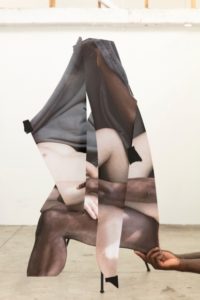
His starting point or basic material for many photographs is a mirror. On that he glues fragments of previously made photos (or drawings). Often they are fragments of naked body parts. From the collage created by performance-like actions – the handwork is visible in the fingerprints on the mirror – he again makes a photograph while parts of a body appear behind or next to the mirror.
Rob Perrée on the photoworks of the American artist Paul Mpagi Sepuya
Mirror Study OX5A6571, 2018
About the photowork of Sepuya
Paul Mpagi Sepuya meets Diego Velasquez
Twelve years ago Paul Mpagi Sepuya published a melancholic self-portrait in Butt Magazine. An unshaven head, a bare-chested body. Probably the portrait was made a few years earlier. It is an interesting photo, in line with the character of the magazine “which opposes the clean-cut image of homosexuality”, but not exceptionally original. In the same series (‘Boys’) there is another self-portrait. One can see that he is sitting on a bed in jeans, his body slightly turned to the right. His (brown) right hand is held at the bottom left of the screen by a (white) hand. It is unclear who owns that hand.
You could call that photo an early version of the work that Sepuya has made in recent years and that recently was not only purchased and exhibited by the MoMA in New York, but has been shown in a growing number of other museums.
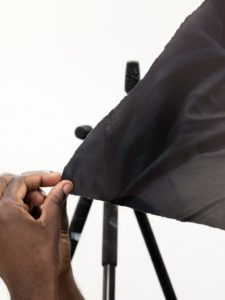
Figure Ground Study, Q5A2086, 2016
Paul Mpagi Sepuya (1982) obtained a BFA in 2004 from the Tisch School of the Arts in New York. He made his first works from his apartment in Brooklyn. Later he moved to Los Angeles to get his MFA at UCLA. There he could exchange his living room for a real studio.
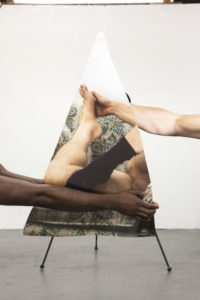
Mirror Study, Self with Robbie 4R2A0857.
Sepuya is a studio photographer. His photographs are taken in a fixed location. They are staged but not fully thought out in advance. In the staging process, the artist grants himself every freedom. His starting point or basic material for many photographs is a mirror. On that he glues fragments of previously made photos. Often they are fragments of naked body parts. From the collage created by performance-like actions – the handwork is visible in the fingerprints on the mirror – he again makes a photograph while parts of a body appear behind or next to the mirror. In many cases the camera of the artist is visible in the heart of the photo.
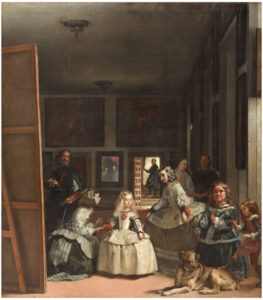
Diego Velasques, Las Meninas, 1656
I almost know for sure that Sepuya must have been inspired by ‘Las Meninas’, the world-famous painting by Velasquez from 1656, where professionals have been racking their brains for centuries to fathom their stratification.
The work portrays the Spanish royal family. In the middle of the painting is the daughter of Philip IV, surrounded by two ladies-in-waiting (Meninas). For that, two dwarfs and a sheepdog. On the left side the painter himself, partly hidden behind a more than man-sized canvas, brush in the right hand and palette in the left hand. He looks at the viewer, not at the canvas. In a mirror in the background the subject of the painting is reflected: the royal couple. A vague reflection that seems to become even more vague due to the clear image of a man, visible through an open door, which steps up a staircase, and looks back to take the scene into consideration.

Mirror Study, 0X5A1317, 2017
As with Velasquez, you wonder what the subject is of many of Sepuya’s works. What is it about? Velasquez challenges the traditional ceremonial portrait, his American colleague gives a new interpretation of the traditional photo portrait. Both artists find it important that their work material is visible. The canvas, the brush and the palette for Velasquez, the camera and the fingerprints on the mirror in case of Sepuya. Both make themselves part of the work. Both seem to focus directly on the viewer: Velasquez looks away from his canvas in the direction of the viewer, Sepuya points the camera – the extension of his eyes – at the viewer. The mirror plays a major role in the work of both of them. Velasquez’s portrait of the royal couple is reflected in a mirror in the back of the room – vague, difficult to see – Sepuya uses a more ingenious method: he obscures the reflection of his body by glueing photographs on the mirror or he hides part of his body behind the mirror. Both work with more perspectives, putting the role and position of the viewer into question: who looks at who and at what? The viewer looks but is also viewed. The layering of the work makes it difficult for the viewer to focus. The ‘viewing objects’ have no hierarchy, in other words, they do not adhere to the traditional, known hierarchy.
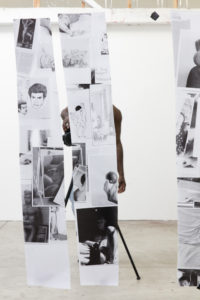
Studio, 0X5A0173, 2017
The big difference between the two artists is the emotional charge of the works. Paul Mpagi captures desire. That is why he selects his models out of his circle of friends. His photo works are erotic. The visible parts of the body are naked, they almost always come from two men – Dear ones? Friends? Colleagues? – who also have a different skin color. The works are highly suggestive. The viewer is drawn into the work. It is therefore perhaps more correct to say that he is challenging the limits of the pornographic gay representation. He denounces the coarse immediacy of it by making it a subtle, intriguing and the fantasy stimulating game. Implicitly he also abolishes the gap between photographs that are considered low art and photographs that are seen as high-art.
*
Las Meninas may be a reaction to the traditional ceremonial portrait, it is also a large painting with a solemn theme. It is seen as art, because it is a painting by a well-known artist. It creates distance. If it arouses feelings, it will be anger of the viewer who does not like to spot with royal figures, emotion because of the central role of the shining little princess (see the featured girl on the Night Watch of Rembrandt), or disgust because of the major role of the ‘deformed’ dwarfs. These feelings do not give the viewers the sense that they are involved in what is presented to them.

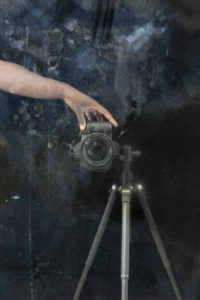
Darkroom Mirror, 0X5A1531, 2017/Darkroom Mirror Study, 0X5A1525, 2017
In 2017 Sepuya made a series of photos with the collective name Dark Room Mirror. They differ from its other work because they play with different and fewer perspectives. The artist and another young man – both naked and partly in the picture – put a camera against the background of a spotty black mirror on which fingerprints can be seen. The artwork is the reflection of these actions in another mirror, bare, not covered with fragments of other photographs. In these works, the suggestive character of the title – dark room – may be more than that of the image. The number of stimulating visual elements is less.
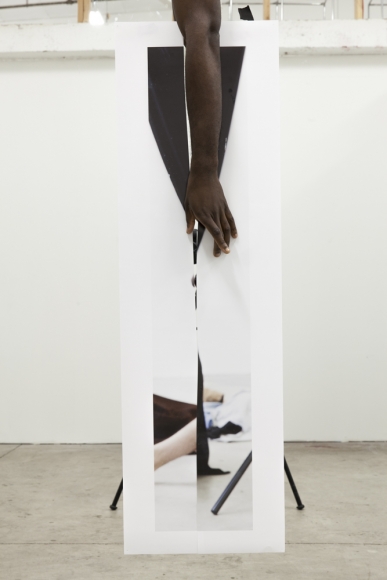
Mirror Study, MG, 1237, 2017
In interviews, Sepuya calls Richard Bruce Nugent (1906-1987) as someone who has influenced him. He would have liked to have made a portrait of him. Nugent was a black writer and artist who played a role in the Harlem Renaissance, the revival of African American culture in the first quarter of the last century in Harlem. He was part of the group referred to as the niggeratti, young black writers and artists, who, in 1926, published the magazine FIRE !! For the first issue of that magazine (unfortunately there was never a second edition because the money ran out) he wrote the modernist, homo-erotic story Smoke Lilies and Jade. It is believed to be the first ever homoerotic story by a black American author. It is about the dreams and desires of Alex. Beauty is the main character in those dreams in which references to existing friends and colleagues also appear. The style is remarkable. Nugent also uses fragmentation to give his story a suggestive charge. Just as there are fragments of images in the work of Sepuya, Nugent writes fragments of phrases that all end (or start, because the beginning and the end merge) in triplets …The magazine was banned in Boston and from many stores in Harlem. Proof that Nugent was far ahead of his time. This fact will undoubtedly play a role in the admiration that Sepyua has for him.

Reflecting Dureau, 2017
In an interview with the magazine GlamCult (September 2018) Paul Mpagi Sepuya says:
I am interested in making pictures that are formally strong and can stand for themselves, but in order to actually understand the work, you have to do with the medium or discipline-specific things and you do not know what to do with.
At the bottom of the story Nugent writes: “… To Be Continued …” . That never happened. Sepuya will not have that problem.
